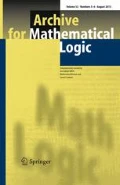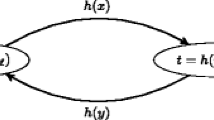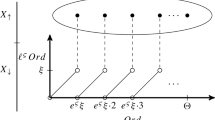Abstract
Let T be a simple L-theory and let \(T^-\) be a reduct of T to a sublanguage \(L^-\) of L. For variables x, we call an \(\emptyset \)-invariant set \(\Gamma (x)\) in \({\mathcal {C}}\) a universal transducer if for every formula \(\phi ^-(x,y)\in L^-\) and every a,
We show that there is a greatest universal transducer \(\tilde{\Gamma }_x\) (for any x) and it is type-definable. In particular, the forking topology on \(S_y(T)\) refines the forking topology on \(S_y(T^-)\) for all y. Moreover, we describe the set of universal transducers in terms of certain topology on the Stone space and show that \(\tilde{\Gamma }_x\) is the unique universal transducer that is \(L^-\)-type-definable with parameters. If \(T^-\) is a theory with the wnfcp (the weak nfcp) and T is the theory of its lovely pairs of models we show that \(\tilde{\Gamma }_x=(x=x)\) and give a more precise description of the set of universal transducers for the special case where \(T^-\) has the nfcp.
Similar content being viewed by others
References
Ben-Yaacov, I., Pillay, A., Vassiliev, E.: Lovely pairs of models. Ann. Pure Appl. Logic 122(1–3), 235–261 (2003)
Hrushovski, E.: Countable unidimensional stable theories are superstable. unpublished note
Nubling, Herwig: Reducts of stable, CM-trivial theories. J. Symb. Logic 70(4), 1025–1036 (2005)
Hart, B., Kim, B., Pillay, A.: Coordinatization and canonical bases in simple theories. J. Symb. Logic 65, 293–309 (2000)
Kim, B., Pillay, A.: Simple theories. Ann. Pure Appl. Logic 88, 149–164 (1997)
Pillay, A.: On countable simple unidimensional theories. J. Symb. Logic 68(4), 1377–1384 (2003)
Shami, Z.: On analyzability in the forking topology for simple theories. Ann. Pure Appl. Logic 142(1–3), 115–124 (2006)
Shami, Z.: Countable hypersimple unidimensional theories. J. Lond. Math. Soc. 83(2), 309–332 (2011)
Shami, Z.: On uncountable hypersimple unidimensional theories. Arch. Math. Logic 53(1–2), 203–210 (2014)
Shami, Z.: A dichotomy for D-rank 1 types in simple theories. Isr. J. Math. 209(2), 993–1012 (2015)
Wagner, F.O.: Simple Theories. Academic Publishers, Dordrecht (2000)
Author information
Authors and Affiliations
Corresponding author
Additional information
Publisher's Note
Springer Nature remains neutral with regard to jurisdictional claims in published maps and institutional affiliations.
Rights and permissions
About this article
Cite this article
Shami, Z. On the forking topology of a reduct of a simple theory. Arch. Math. Logic 59, 313–324 (2020). https://doi.org/10.1007/s00153-019-00691-w
Received:
Accepted:
Published:
Issue Date:
DOI: https://doi.org/10.1007/s00153-019-00691-w




